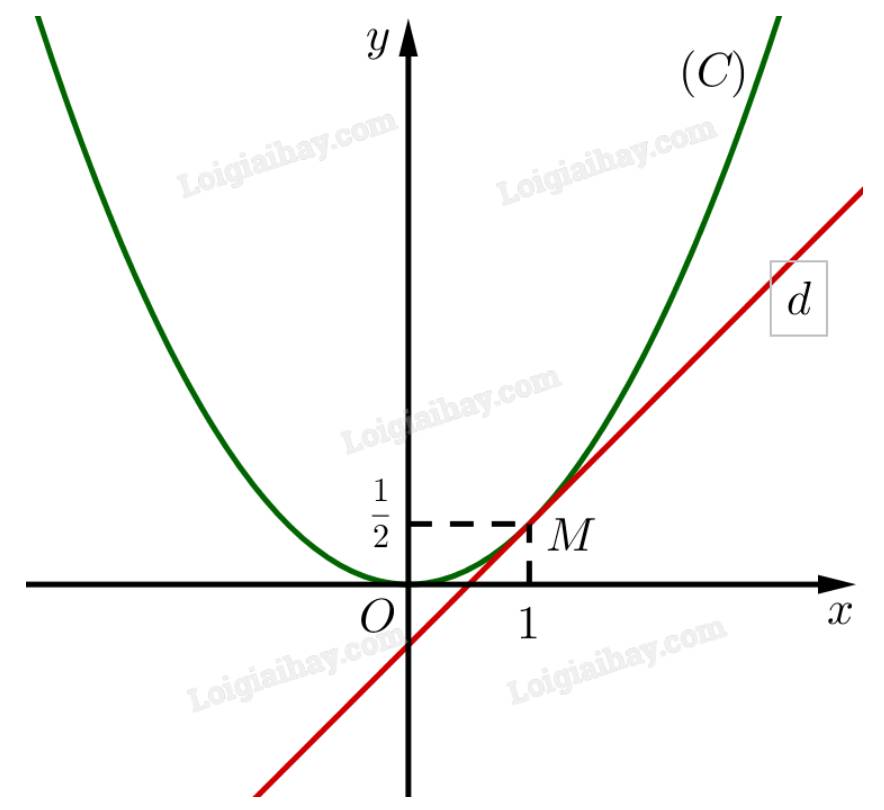Bài 1: Cho hàm số \(y=\left(x\right)=-\frac{1}{2}x\)
a) Tính f( -2); f( 3)
b) Vẽ đồ thị hàm số \(y=f\left(x\right)-\frac{1}{2}x\)
Hãy nhập câu hỏi của bạn vào đây, nếu là tài khoản VIP, bạn sẽ được ưu tiên trả lời.

\(\text{1)}\)
\(\text{Thay }x=-2,\text{ ta có: }f\left(-2\right)-5f\left(-2\right)=\left(-2\right)^2\Rightarrow f\left(-2\right)=-1\)
\(\Rightarrow f\left(x\right)=x^2+5f\left(-2\right)=x^2-5\)
\(f\left(3\right)=3^2-5\)
\(\text{2)}\)
\(\text{Thay }x=1,\text{ ta có: }f\left(1\right)+f\left(1\right)+f\left(1\right)=6\Rightarrow f\left(1\right)=2\)
\(\text{Thay }x=-1,\text{ ta có: }f\left(-1\right)+f\left(-1\right)+2=6\Rightarrow f\left(-1\right)=2\)
\(\text{3)}\)
\(\text{Thay }x=2,\text{ ta có: }f\left(2\right)+3f\left(\frac{1}{2}\right)=2^2\text{ (1)}\)
\(\text{Thay }x=\frac{1}{2},\text{ ta có: }f\left(\frac{1}{2}\right)+3f\left(2\right)=\left(\frac{1}{2}\right)^2\text{ (2)}\)
\(\text{(1) - 3}\times\text{(2) }\Rightarrow f\left(2\right)+3f\left(\frac{1}{2}\right)-3f\left(\frac{1}{2}\right)-9f\left(2\right)=4-\frac{1}{4}\)
\(\Rightarrow-8f\left(2\right)=\frac{15}{4}\Rightarrow f\left(2\right)=-\frac{15}{32}\)

a/ Thay x =0 vào hàm số f(x) = 2x2 - 10 ta có
f(0) = 2 . 0 - 10 = -10
Thay x = 1 vào hàm số f(x) = 2x2 - 10 ta có
f(1) = 2 . 12 - 10 = 2 - 10 = -8
Thay \(x=-1\dfrac{1}{2}=-\dfrac{3}{2}\)vào hàm số f(x) ta có
\(f\left(-1\dfrac{1}{2}\right)=2.\left(-\dfrac{3}{2}\right)^2-10=\dfrac{9}{2}-\dfrac{20}{2}=-\dfrac{11}{2}\)
b/ f(x) = -2
\(\Leftrightarrow2x^2=8\)
\(\Leftrightarrow x^2=4\Leftrightarrow x=\pm2\)

a)
\(\begin{array}{l}f'\left( 1 \right) = \mathop {\lim }\limits_{x \to 1} \frac{{f\left( x \right) - f\left( 1 \right)}}{{x - 1}} = \mathop {\lim }\limits_{x \to 1} \frac{{\frac{1}{2}{x^2} - \frac{1}{2}}}{{x - 1}} = \mathop {\lim }\limits_{x \to 1} \frac{{\frac{1}{2}\left( {{x^2} - 1} \right)}}{{x - 1}} = \mathop {\lim }\limits_{x \to 1} \frac{{\frac{1}{2}\left( {x - 1} \right)\left( {x + 1} \right)}}{{x - 1}}\\ = \mathop {\lim }\limits_{x \to 1} \frac{1}{2}\left( {x + 1} \right) = \frac{1}{2}\left( {1 + 1} \right) = 1\end{array}\)
b) Phương trình đường thẳng \(d\) đi qua điểm \(M\left( {1;\frac{1}{2}} \right)\) và có hệ số góc bằng \(k = f'\left( 1 \right) = 1\) là: \(y - \frac{1}{2} = 1\left( {x - 1} \right) \Leftrightarrow y = x - 1 + \frac{1}{2} \Leftrightarrow y = x - \frac{1}{2}\).

Đường thẳng \(d\) cắt đồ thị hàm số \(\left( C \right)\) tại duy nhất điểm \(M\left( {1;\frac{1}{2}} \right)\).

Bài 1:
\(f\left(-x\right)=\left|\left(-x\right)^3+x\right|=\left|-x^3+x\right|=\left|-\left(x^3-x\right)\right|=\left|x^3-x\right|=f\left(x\right)\)
Vậy hàm số chẵn
Bài 2:
\(f\left(4\right)=4-3=1\\ f\left(-1\right)=2.1+1-3=0\\ b,\text{Thay }x=4;y=1\Leftrightarrow4-3=1\left(\text{đúng}\right)\\ \Leftrightarrow A\left(4;1\right)\in\left(C\right)\\ \text{Thay }x=-1;y=-4\Leftrightarrow2\left(-1\right)^2+1-3=-4\left(\text{vô lí}\right)\\ \Leftrightarrow B\left(-1;-4\right)\notin\left(C\right)\)

Áp dụng tính chất của dãy tỉ số bằng nhau, ta có:
\(\frac{\left|x-5\right|}{\left|x-3\right|}=\frac{\left|x-1\right|}{\left|x-3\right|}=\frac{\left|x-5\right|-\left|x-1\right|}{\left|x-3\right|-\left|x-3\right|}=\frac{\left|x-5\right|-\left|x-1\right|}{0}\)
Do đó không tồn tại x thỏa mãn.

a) \(f\left(\frac{-1}{2}\right)\)
Thay x = -1/2 vào ta được: \(y=f\left(\frac{-1}{2}\right)=\left(\frac{-1}{2}\right)^2-5.\left(\frac{-1}{2}\right)+1=\frac{15}{4}\)
\(f\left(3\right)\)
Thay x = 3 vào ta được: \(y=f\left(3\right)=3^2-5.3+1=-5\)
b) Để f(x) = 1
Suy ra: \(x^2-5x+1=1\)
\(\Leftrightarrow x^2-5x=0\)
\(\Leftrightarrow x\left(x-5\right)=0\)
\(\Leftrightarrow\orbr{\begin{cases}x=0\\x=5\end{cases}}\)
Vậy khi x = 0 hoặc x = 5 thì f(x) = 1

Đặt \(h\left( x \right) = f\left( x \right) + g\left( x \right) = \frac{1}{{x - 1}} + \sqrt {4 - x} \). Ta có:
\(\begin{array}{l}h\left( 2 \right) = \frac{1}{{2 - 1}} + \sqrt {4 - 2} = 1 + \sqrt 2 \\\mathop {\lim }\limits_{x \to 2} h\left( x \right) = \mathop {\lim }\limits_{x \to x} \left( {\frac{1}{{x - 1}} + \sqrt {4 - x} } \right) = \frac{1}{{2 - 1}} + \sqrt {4 - 2} = 1 + \sqrt 2 \end{array}\)
Vì \(\mathop {\lim }\limits_{x \to 2} h\left( x \right) = h\left( 2 \right)\) nên hàm số \(y = f\left( x \right) + g\left( x \right)\) liên tục tại \(x = 2\).
a) \(y=f\left(x\right)=-\frac{1}{2}x\)
\(f\left(-2\right)=-\frac{1}{2}.\left(-2\right)=1\)
\(f\left(3\right)=-\frac{1}{2}.3=-\frac{3}{2}\)
b)
Cho \(x=1\Rightarrow y=-\frac{1}{2}.1=-\frac{1}{2}\)
\(\Rightarrow A\left(1;-\frac{1}{2}\right)\)
O 1 2 1 2 -1 -2 -1 -2 -1/2 A y=-1/2x
Hình ko đẹp lắm mong cậu thông cảm